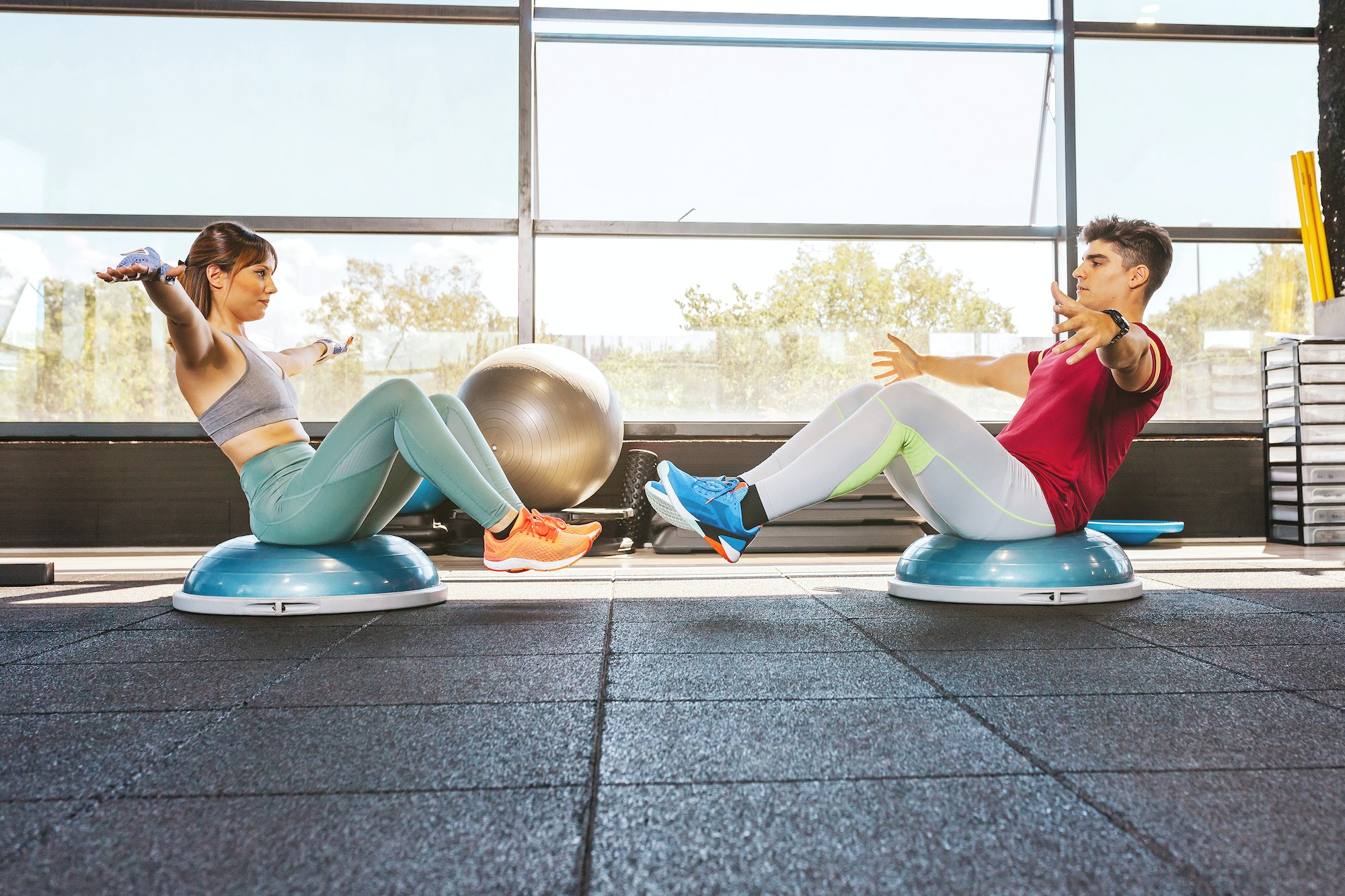Stability balls and BOSU balls are two pieces of equipment commonly used in gyms. While they are similar pieces of equipment, they have key differences.
Key similarities between stability balls and BOSU balls include:
- Both are great for balance and stability training
- Both improve core strength
- Both are friendly for beginners and advanced athletes
- Both are versatile- can be used for a substantial variety of exercises
Stability Balls vs. BOSU Balls Overall Comparison
| Attribute | Stability Ball | BOSU Ball |
| Versatility | Great | Great |
| Upper Body Strength | Minimal | Good |
| Lower Body Strength | Good | Great |
| Cardio | Minimal | Good |
| Core Strength | Great (better for intermediate/advanced) | Great (better for beginner/intermediate) |
| Balance | Good | Great |
| Cost | Affordable | Expensive |
| Portability | Difficult | Easy |
Key Advantages Of Stability Balls
Stability balls are better for intermediate to advanced athletes, and provide more benefits to core strength and trunk control compared to BOSU balls. Stability balls are also useful for beginner athletes looking to improve posture control.
Stability balls provide a plethora of options for core training. While there are easier exercise selection ideas, most core exercises with a stability ball are on the challenging side.
Stability balls can increase the range of motion you perform when doing a crunch. They also provide a significantly unsteady surface for performing prone and quadruped exercises, such as a plank or a bird dog.
When forced to overcome an unsteady surface, the deep core muscles, including the transverse abdominis and obliques, must work harder to maintain a neutral spine. This makes the stability ball a great option for intermediate to advanced athletes.
Stability balls are also useful for less experienced athletes looking to improve postural muscle control.
By performing exercise sitting on a stability ball, athletes are forced to recruit their trunk postural muscles to maintain an upright position. This is useful for any athlete of any skill level; particularly, those who spend considerable time sitting for long periods.
Stability balls are also a very affordable option for those looking to add to their home exercise collection. Most stability balls cost around $30 or so.
Key Advantages Of BOSU Balls
BOSU balls are better for beginner to intermediate athletes and provide more benefits for standing balance training. BOSU balls also provide more variety for lower body and cardio training compared to stability balls.
Because of their dome and flat surfaces, BOSU balls provide a variety of options for balance training. It’s much easier and safer to do standing balance exercises on a BOSU ball than on a stability ball.
While there are lower and upper body exercises that can be performed with a stability ball, BOSU balls provide more variety, since they can be stood on, as well as held in a push-up position on the ground. Exercises like squats, lunges, and push-ups are easy to perform on a BOSU ball.
BOSU balls are also commonly used for cardio training. They are useful tools for cardio exercises like toe taps and side stepovers.
BOSU balls are also easier to store, as they take up less room in storage space compared to other exercise equipment.
Stability Ball vs. BOSU Ball: Upper Body Strength
The BOSU ball is the better choice if the goal is to improve upper body strength. Upper body exercise options with a stability ball are limited.
The BOSU ball can be positioned with either side up to perform a variety of push-up variations. BOSU balls are also heavier than stability balls, and can be used for overhead presses and curls (most likely in conjunction with another exercise such as a burpee).
Stability balls can be used for upper body range of motion exercise; however, their role in upper body strength exercise is limited, especially for beginner athletes.
Users can also sit on the stability ball during upper body exercises such as rows or face pulls as a way to challenge the core and postural muscles during upper body exercises. However, the stability ball does not have much utility for direct upper body strength training.
Stability Ball vs. BOSU Ball: Lower Body Strength
Both stability balls and BOSU balls are useful for lower body strength training. BOSU balls narrowly edge stability balls due to the variety of lower body strength exercises available.
BOSU balls can be used to perform various lower body exercises, such as squats, lunges, and single-leg RDLs. These exercises can be performed with the flat side or dome side up.
By using a BOSU ball for lower body exercises, your stabilizer muscles have to work harder to keep your balance and maintain good technique. As a result, BOSU balls are a great way to enhance lower body strength training.
Stability balls can be used for lower body exercises such as hamstring curls, bridges, and wall squats. These can be made easier or harder, depending on the athlete’s skill level.
Stability Ball vs. BOSU Ball: Core Strength
Both stability balls and BOSU balls are great tools for improving core strength. Stability balls are better for more advanced core exercises, and BOSU balls are better for beginner to intermediate core training.
Some intermediate to advanced level stability ball exercises include:
- Planks
- Stir the pots
- Tucks
- Pikes
- Bird Dogs
- Dead Bugs
- V-Ups
- Crunches
BOSU balls can be used for crunches and planks as well; however, the degree of difficulty isn’t as great as it is compared to a stability ball.
While BOSU balls do provide an unsteady surface, the BOSU is inherently more stable than the stability ball, making it a better option for beginner athletes.
Stability Ball vs. BOSU Ball: Injury Recovery And Prevention
Both the stability ball and BOSU ball are used by physical therapists to help patients recover from and prevent injury.
Stability balls are used by physical therapists to help patients reduce pain and increase their range of motion. Stability balls are great for assisted range of motion of the shoulder, lower back, hips, and knees.
Physical therapists also use stability balls to strengthen the legs and core of patients with back, hip, and knee injuries.
BOSU balls are used by physical therapists to help patients improve their balance and stability in the ankles, knees, hips, and shoulders.
The unstable nature of the BOSU ball is great for providing proprioceptive feedback to help patients keep their balance and prevent falls.
Who Is A Stability Ball For?
The stability ball is for intermediate to advanced athletes looking for a way to progress their core and trunk stability training. It is also for everyday athletes looking to improve their posture control.
Because of its inherent instability and versatility for core training, a stability ball is a great tool for athletes looking to level up their core training.
A stability ball is also a great tool that anyone can use for sitting balance exercise that promotes postural control and awareness.
The stability ball has its uses for lower and upper body exercise; however, there are better tools on the market that are more versatile if lower and upper body strength is the goal.
Stability balls are also very budget-friendly; however, they are also more difficult to transport and store. Due to their bulk, they do not store as easily as other gym equipment.
What To Look For When Buying Stability Ball
When buying a stability ball, the most important things to look for are durability and size. Choosing the right stability ball will optimize workout performance and reduce the risk of injury.
Stability balls should be made of explosion-proof material. This would ensure the ball slowly and safely deflates, rather than explodes if it were to be damaged accidentally.
Choosing the right size stability ball is important for exercise technique and body mechanics.
Exercise balls come in three sizes, and in most cases, should be chosen based on the user’s height. Recommended sizing for the stability ball is below:
- Under 5’4”: 55cm stability ball
- 5’4” to 5’11”: 65cm stability ball
- 6’0” or taller: 75cm stability ball
There are some exercises, such as V-ups or hamstring curls, where a smaller-sized ball may be more useful for taller individuals. However, for the majority of exercises, sizing is proportionate to height.
Who Is A Bosu Ball For?
The BOSU ball is for individuals looking to improve their balance, stability, and core strength. It is also useful for upper and lower body strength training and cardio for those looking to add a challenging variety to their training.
BOSU balls are the better choice for balance and stability training since their structure allows for standing on either side of the ball. BOSU balls challenge the stabilizer muscles in your body to work harder to maintain standing balance.
BOSU balls are also great for core strength and control due to their inherent unsteady nature. Your core muscles work harder to maintain trunk control during an upper or lower body exercise using a BOSU ball.
BOSU balls are significantly more expensive than stability balls; however, they are much easier to store due to their smaller size. They take up less space and are easier to transport.
What To Look For When Buying
When buying a BOSU ball, it is most important to look at durability, size, and design.
BOSU balls should come with non-slip surfaces on their flat side, and durable material capable of maintaining at least 800 pounds of resistance without damaging the ball.
BOSU balls also come in different sizes (though the size differences are marginal, they are still significant). A standard BOSU ball is 26 inches in diameter.
How To Choose Between Stability Balls And BOSU Balls
If your goal is to improve your core strength, and you’re on a tighter budget, the best choice is a stability ball. If your goal is to improve balance and you have limited storage space, the best choice is a BOSU ball.
The table below describes some key needs and goals and picks which one is better for you based on those needs and goals.
| Need/Goal | Stability Ball or BOSU Ball |
| Improve Core Strength | Stability Ball |
| Improve Balance | BOSU Ball |
| Improve Upper Body Strength | BOSU Ball |
| Improve Lower Body Strength | Either |
| Beginner-Friendly | BOSU Ball |
| Affordable | Stability Ball |
| Improve Posture | Stability Ball |
A stability ball is the best pick if you are:
- An intermediate to advanced athlete
- Trying to improve core strength
- Looking to improve posture
- On a budget and in need of a versatile piece of equipment
A BOSU ball is the best pick if you are:
- A beginner to intermediate athlete
- Trying to improve your balance
- Want to add variety to upper and lower body strength training
- Limited storage space for exercise equipment
Ultimately, both stability balls and BOSU balls are great tools for improving strength, balance, and overall fitness levels. Your training goals should be the key when choosing between a stability ball and a BOSU ball.

Austin is the author of loveatfirstfit.com and a personal trainer with extensive knowledge in nutrition. Austin is passionate about helping others to find a suitable healthy lifestyle and feel good about themselves. Austin’s goal is to help people push their limits and achieve their physical performance.

